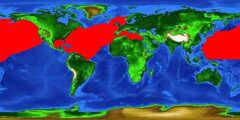Location

As you can clearly see the Blue Fin Tuna Resides in the alantic and pacific ocean's and through out their lives they migrate.
Habitat
The Blue Fin Tuna is epipelagic and oceanic, coming near shore seasonally. Due to the fact that Blue Fins are warm blooded they prefer colder waters but tolerate warm climates as well. And they have been observed to dwell in depths up to 914.4 meters
Diet
Blue Fin consume smaller fishs such as Mackerel, Herring, Whiting, Flying Fish, and Mullet as well as Squid, Eels, and Crustaceans.
LifeStyle
- Whe the Blue Fin is at a young age it seperates into schools according to size and these schools are a wide variteys of species.
- They grow at a rate of 1mm a day.
- During their lifetime they migrate thousands of kilometers.
- The largest confirmed blue fin was 180 inches long and the heaviest was 1506 lbs.
- There are only two confirmed locations of reproduction.
- And have an average life span of 15-30 years
Reproductive Strategies
- They have seprate sexes
- Uses Externl fertalization, Females lay up to a thirty million eggs at once while the Male Releases sperm over the eggs
- Due to the Depth and rarity of these fish, There is no accurate information for the mates of these fish and how many seasons they are together
- There are 2 confirmed breeding locations one is in the Golf Of Mexico and the other in the Mediterranea Sea
- The Science on breeding Blue Fin is still under development due to the fact that Blue Fin in captivity can take up to 12 years to reach sexual maturaity puts a big chunk in the potential breeders pocket
- Also Blue Fin mateing outside of there natural habitat is difficult
- 1-2 days is the average gestation period
- And their is no parental care due to the fact that the eggs could float to up to thousands of miles before they hacth